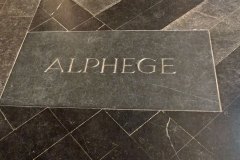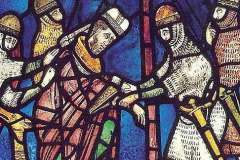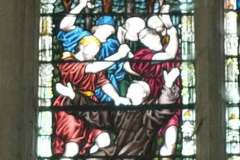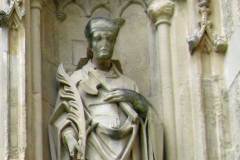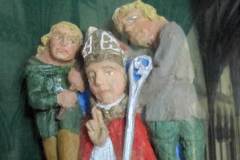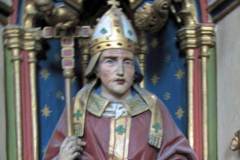Archbishop of Canterbury, Martyr & Saint
Alphege (Elphege, Alfege, and many variants) was born in the village of Weston near Bath and became an anchorite (form of hermit), later a monk at Deerhurst in Gloucestershire. He was appointed Abbot of Bath by Dunstan, and later Bishop of Winchester (984 AD) and Archbishop of Canterbury (1005 AD). By 1011 AD, the Danes had conquered much of southern England, and in September that year turned their attention to Canterbury. They plundered the city, burnt the cathedral and took many local inhabitants to be sold as slaves or (as in the case of Alphege) to be held to ransom. Taken by ship to Greenwich, Alphege declared that his ransom was too high and not to be paid. During a drunken revel on 19 April 1012, the Danes pelted Alphege with ox bones, and finally with an axe head, which left him dead. The spot is marked by the present Greenwich church of St Alfege (here spelt this way). Originally buried in St Paul’s in London, his remains were ‘translated’ to Canterbury in 1023 by order of King Canute. He became a saint in 1078, despite some doubts whether he had actually died for his faith or died to avoid a ransom payment. Thomas Becket prayed to him in 1170 just before his own murder. The 1000th year anniversary of his death has recently been commemorated in Canterbury and elsewhere with walks, talks, discussions etc.
What to see:
- the stone marking his burial place beside the high altar (Image 1); when Archbishop George Carey was enthroned on St Alphege day 19 April 1991, he paused to honour this spot
- stained glass in the north aisle of the choir (Image 2) depicting his removal and murder by the Danes – the earliest surviving depiction in England of warfare in stained glass
- modern stained glass in the Chapter House (Image 3)
- statue by Phyffers on the east external wall of the south west porch (Image 4)
- figures behind glass in the cloisters (Image 5) – these are modern reproductions of original roof bosses which were lost in the 17th century
- there is also an image of St Alphege (carrying stones with which the Danes pelted him) on the Chichele tomb (Image 6)
Sources: see basic cathedral sources; also Green (1995); Knowles (1962); Lucy (1997)
DL

